Peter Anton von Verschaffelt
Verschaffelt – Nr 01
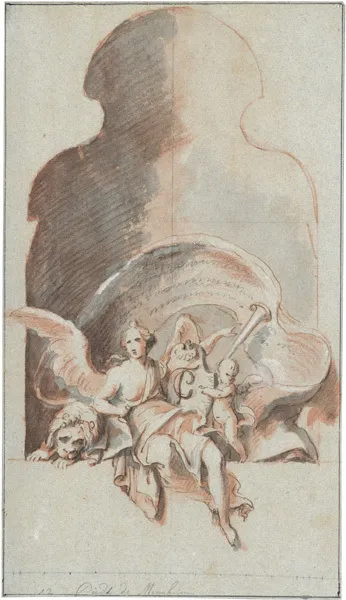
Peter Anton von Verschaffelt (Gent 1710 – 1793 Mannheim) – Fama.
Sketch for a façade sculpture. Grey washed ink drawing in brown with red chalk and pencilled grid lines and bordering in Indian ink.
On the lower edge, written in brown ink the measurements „12 Piedt de Mannheim“ (trimmed) as well as the measurements in pencil. Verso, traces of grey wash. On delicate grey blue laid paper with watermark „IFLNST“.¹ Size: 33,1 x 18,8 cm. On the left hand margin mounted on original pale yellow coloured laid paper base with watermark „Crowned coat of arms with bend“ as well as marking verso in brown ink „A. No. 23“. Minimal signs of folding.
Provenance: Private collection, Baden-Württemberg, acquired in the Stuttgart art market in 1974.
Following the death of his predecessor Paul Egell, also court sculptor to the elector Carl Theodor, Verschaffelt initially completed the sculptural adornments for the Jesuit church in Mannheim. Egell had only completed the gable relief, so that his successor became responsible for the working out of the sculptures on the façade, the high altar, the side altar and the holy water font.
In a payment order of the court chamber from the year 1757, there is already a mention of a statue, representing Fama.² Fama, according to old Roman poetry, originally epitomised the reputation of a person; in later times she represented the allegory of glory. The drawing at hand, depicting the goddess seated on a lion with a trombone, flanked by a cherub, is a direct preparatory drawing for the sculpture, which was later executed and placed on the ledge of the middle window over the portal of the Jesuit church. A particular detail is the coat of arms with the ligated monogram „CT“of the elector Carl Theodor in the centre of the depiction.
¹ Cf. Jaffé 1935, Nr 14a. Paper mill Johann Friedrich Lorch, Neustadt.
² Cf. E. Hofmann, P. A. von Verschaffelt, Mannheim 1982, P. 54ff and No. 32.
Verschaffelt – Nr 02

Peter Anton von Verschaffelt (Gent 1710 – 1793 Mannheim) – The electress Elisabeth Auguste as the patroness of sculpture.
Ink drawing in black brown with red chalk with alternations in the area of the coat of arms and with bordering in Indian ink. On delicate grey blue laid paper, with watermark „IFLNST“. ¹ Size: 32,8 x 19,8 cm. On the left hand margin original mounting on pale yellow coloured laid paper base with watermark „Crowned coat of arms“ (fragment) as well as marking verso in brown ink „A. No. 39“. Minimal signs of folding.
Provenance: Private collection, Baden-Württemberg, acquired in the Stuttgart art market in 1974.
In 1742, the electress Elisabeth Auguste from the house of Pfalz-Sulzbach married her cousin Carl Theodor, who shortly afterwards became the successor of the elector Carl Philipp. The couple were seen as the most art-appreciative electors of their time. Their residence town of Mannheim counted as the most important art metropolis north of the Alps. Friedrich Schiller described it as the „Paradise of the Muses“. The drawing at hand shows Elisabeth Auguste seated on a throne in an allegorical manner.
In a protective gesture she enfolds a female figure, at whose feet lie the attributes of sculpturing and who points towards a shield, held by the electress, depicting the image of man wearing a helmet. What is interesting is that Verschaffelt himself worked on an older version of the oval drawing with a depiction of the man with a helmet. The depiction, which lies underneath the alteration backed on to the top margin, shows a female figure as a bust in profile, regarding a sculpture of a female figure with a diadem, also shown in profile. The drawing is similar in its representation to the medallions, which were embossed for the wedding of the young couple.²
¹ Cf. Jaffé 1935, No. 14a. Paper mill Johann Friedrich Lorch, Neustadt.
² Cf. Lebenslust und Frömmigkeit 1999, Vol. 2, No. 1.1.12.
Verschaffelt – Nr 03
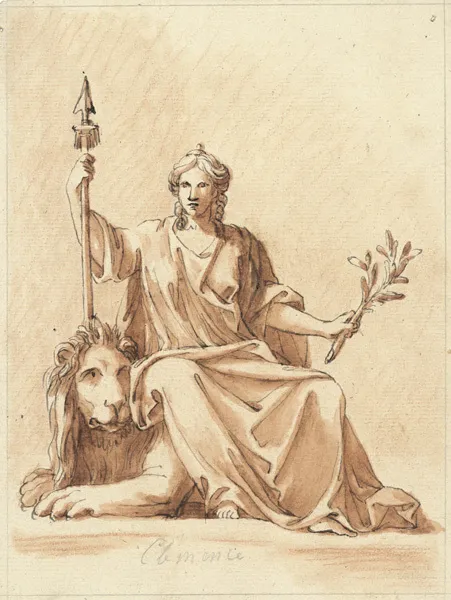
Peter Anton von Verschaffelt (Gent 1710 – 1793 Mannheim) – „Clemente“.
Ink drawing in black brown with red chalk and with bordering in pencil. Titled in pencil. On chamois coloured laid paper. Size: 22,2 x 15,3 cm. With a few tiny holes.
Provenance: Private collection, Baden-Württemberg, acquired in the Stuttgart art market in 1974.
Elisabeth Auguste, the wife of the elector Carl Theodor, is shown here as the charitable mother of the State. In other compositions, she is shown as the goddess Minerva or as the personification of generosity (Magnanimità). Her attributes for this are the sceptre, the tamed palatine lion and the horn of plenty.
In the drawing at hand, the horn of plenty is replaced by an olive branch – as a sign of a peaceful reign for the electoral couple. The marking „Clemente“ alludes to one of the noblest virtues for an electress – charity and goodness. The subject of the drawing takes up on the iconography that Verschaffelt had already used in the preparatory sketch for a standing alcove statue. The drawing at hand served as a composition sketch for the portrait of the Mannheim court painter Carl Heinrich Brand.¹
¹ Cf. Städtisches Reiss-Museum Mannheim, P. A. von Verschaffelt, Mannheim, 1976, No. 38 b and c. Lebenslust und Frömmigkeit 1999, Vol. 2, No. 2.0.2. Cf. E. Hofmann, P. A. von Verschaffelt, Mannheim 1982, No. 154.
Verschaffelt – Nr 04
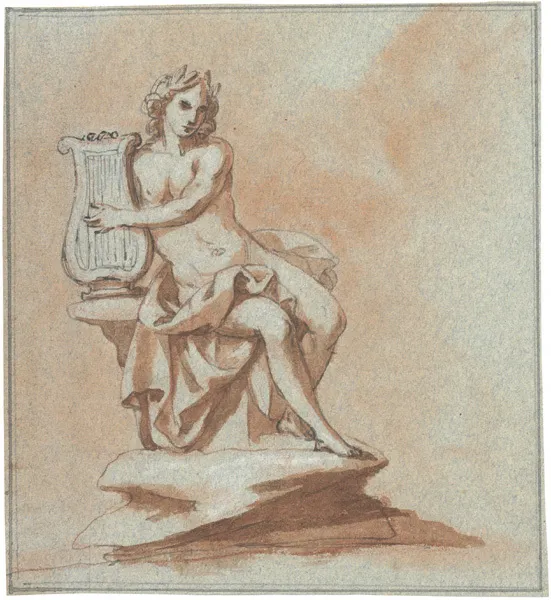
Peter Anton von Verschaffelt (Gent 1710 – 1793 Mannheim) – Apollo with lyre.
Sketch for a statue. Indian ink drawing with red chalk and with bordering. On grey blue laid paper with watermark „IFLNST“.¹ Size: 16,7 x 15,2 cm. On the left margin original mounting on pale yellow coloured laid paper base with watermark „Crowned coat of arms with lily“ (trimmed) as well as marking verso in brown ink „A. No. 169“.
Provenance: Private collection, Baden-Württemberg, acquired in the Stuttgart art market in 1974.
The sculptural adornments of the Schwetzinger castle gardens from the years 1761-1779 represent Verschaffelt’s prime works. Originally the statue in the Temple of Apollo was planned as a seated image, but was later executed as a standing image.
What is remarkable about the drawing at hand, as well as with the executed statue, is that Apollo is on both occasions holding the lyre in his left hand as his most important attribute. This was already criticised by Verschaffelt’s contemporaries. The artist had used a marble block designated for another sculpture, and therefore had to take into consideration the measurements of the block at hand when executing the statue of Apollo.²
¹ Cf. Jaffé 1935, No. 14a. Paper mill Johann Friedrich Lorch, Neustadt.
² Cf. E. Hofmann, P. A. von Verschaffelt, Mannheim 1982, No. 283f.
Verschaffelt – Nr 05
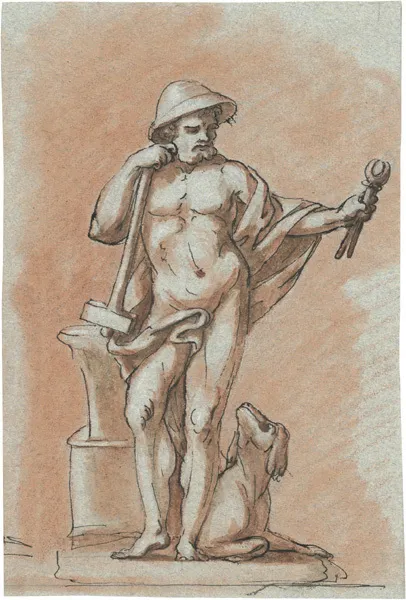
Peter Anton von Verschaffelt (Gent 1710 – 1793 Mannheim) – Vulcanus, standing. Sketch for a statue.
Ink drawing in brown with red chalk. On grey blue laid paper with watermark „Crowned double C“.¹ Size: 19,4 x 13 cm. On the left margin mounted on original beige coloured laid paper base with a fragment of a watermark (Crowned coat of arms ?) as well as marking verso in brown ink „F. No. 55“.
Provenance: Private collection, Baden-Württemberg, acquired in the Stuttgart art market in 1974.
The allegorical depiction shows Vulcanus as the symbol of the element of fire, standing at an anvil with hammer and tongs, at his feet rests a hunting dog. The catalogue of the Reiss-Museum, Mannheim, lists a sketch with the inventory number „LBW 1974/2/52“ showing an almost identical subject, which differs only marginally in the posture and alignment of the figure.²
¹ Cf. Jaffé 1930, No. 33.
² Cf. Städtisches Reiss-Museum Mannheim, P. A. von Verschaffelt, Mannheim, 1976, No. 65 a.
Verschaffelt – Nr 06
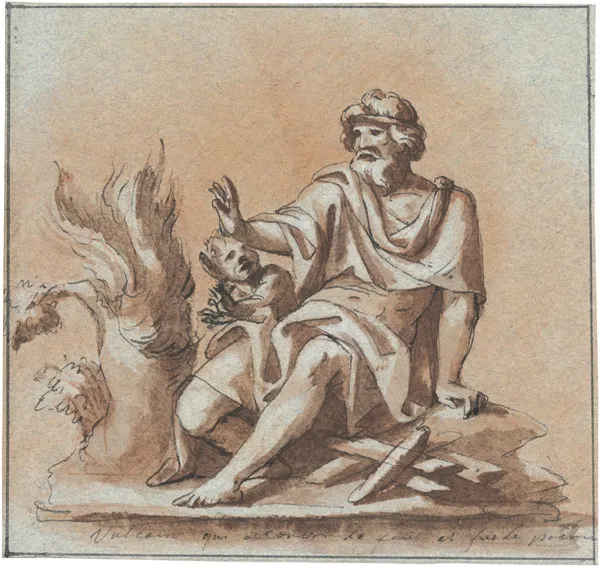
Peter Anton von Verschaffelt (Gent 1710 – 1793 Mannheim) – Vulcanus, seated.
Sketch for a statue. Indian ink drawing with red chalk and bordering. On the lower margin marked in brown ink „Vulcain qui decouvri le feu et fuit le poème“. On grey blue laid paper with watermark „IFLNST“.¹ Size: 16,6 x 17,6 cm. On the left margin mounted on original pale yellow coloured laid paper base as well as marking verso in brown ink „F. No. 282“.
Provenance: Private collection, Baden-Württemberg, acquired in the Stuttgart art market in 1974.
In using the Roman divinities in the Schwetzinger castle garden, Verschaffelt created an allegorical depiction of the four elements. So Juno personified air, Cybele the earth, Neptune the water and Vulcanus the fire. The sketch on hand, which shows the seated god by a blazing fire in the company of a small aiding cherub, did not find a direct sculptural conversion. The definitive version of Vulcanus, which can be found in the main alley of the castle garden, shows a simplified version. The god is shown as a prostrate single figure, and can only be recognised by his attributes of a hammer and Phrygian hat.²
¹ Cf. Jaffé 1935, No. 14a. Paper mill Johann Friedrich Lorch, Neustadt.
² Cf. E. Hofmann, P. A. von Verschaffelt, Mannheim 1982, No. 272ff.
Verschaffelt – Nr 07
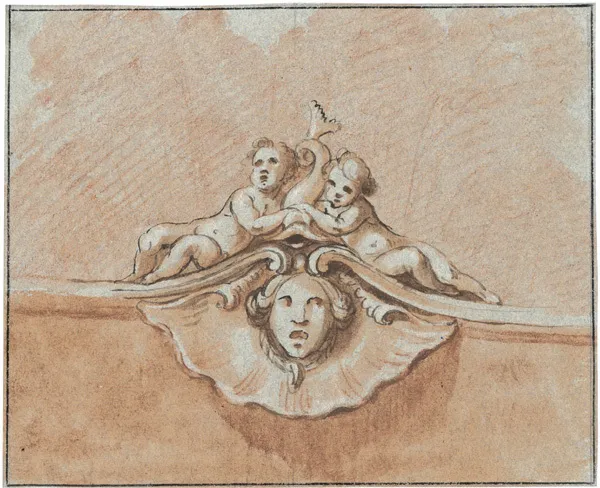
Peter Anton von Verschaffelt (Gent 1710 – 1793 Mannheim) – Dolphin fountain.
Sketch for a water gargoyle. Ink drawing in black brown with red chalk and with bordering in black brown ink. Verso with further ink drawing in black brown with red chalk: sketch for a dolphin fountain (alternative). With measurements in pencil. On grey blue laid paper. Size: 15,5 x 19,2 cm. Original mounting on left margin on pale grey coloured laid paper base as well as marking verso in brown ink „D. No. 9“.
Provenance: Private collection, Baden-Württemberg, acquired in the Stuttgart art market in 1974.
The sketch on hand shows a dolphin with two playing cherubs, who crown upon a stylised head in shell adornment.
Verschaffelt – Nr 09

Peter Anton von Verschaffelt (Gent 1710 – 1793 Mannheim) – Glaucus and Scylla.
Sketch for fountain figures. Ink drawing in brown with red chalk with bordering. Original marking in pencil „Glocus et Cella“ or rather „Idée pour le jardin de Schwetzingen“. On grey blue laid paper with watermark „…nst“ as well as with a further, not identified watermark. Size: 28,1 x 28,3 cm. On the left margin original mounting on pale yellow coloured laid paper base with watermark „Crowned coat of arms with bend“ as well as marking verso in brown ink „DA (ligated) No. 15“ With slight folding.
Provenance: Private collection, Baden-Württemberg, acquired in the Stuttgart art market in 1974.
The sketch on hand shows a couple fleeing from a pack of hunting dogs onto a rock. Ovid, at the beginning of the 14th book of Metamorphosis, tells the story of the transformation of Glaucus and Scylla, by the sorceress Circe, into a dangerous reef before the coast of Sicily. This theme already appeared in the first list of the sculptural program for the Schwetzinger castle garden in 1766, and was planned as a group of figures for the grand basin on the ground floor.¹ This constellation no longer appears in a statement from the court architect Nicolas de Pigage to the works of Verschaffelts in 1773. Its execution probably became superfluous, when several statues were obtained from the estate of the deceased King Stanislaw I Lesczynski of Poland, amongst these, the Arion group by Barthélémy Guibal for the grand basin. ¹ Cf. E. Hofmann, P. A. von Verschaffelt, Mannheim 1982, P. 214ff.
Verschaffelt – Nr 11
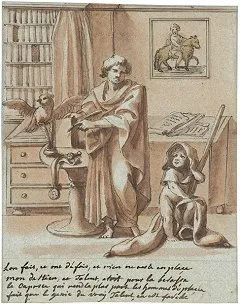
Peter Anton von Verschaffelt (Gent 1710 – 1793 Mannheim) – Scribe in his library.
Ink drawing in black brown and red chalk with bordering in pencil. On grey blue laid paper with watermark „IFLNST“.¹ Size: 22,3 x 17,4 cm. On the left margin original mounting on blue coloured laid paper base with watermark „Crowned coat of arms with lily“ (trimmed) as well as marking verso in brown ink „A. No. 59“. Minimally foxed.
Provenance: Private collection, Baden-Württemberg, acquired in the Stuttgart art market in 1974.
With the four lines of French text, Verschaffelt explains the predestination of human beings to be placed by fate at the right or wrong place. „L’on fait et ont défais, et rien ne reste en place / mon destien, et talent, etait pour la becasse / le caprice qui rend la plupart des homes déplacés / fait que le genie du vray Talent en est fauché „. Represented here is a scribe between an owl and a genius, thus showing two differing roads of life.
¹ Cf. Jaffé 1935, No. 14a. Paper mill Johann Friedrich Lorch, Neustadt.
Verschaffelt – Nr 12

Peter Anton von Verschaffelt (Gent 1710 – 1793 Mannheim) – Drunken Silenus.
Depiction in a transverse oval. Sketch for a relief. Ink drawing in black brown with red chalk with bordering.
On grey blue laid paper with a cut watermark „Crowned double C“.¹ Size: 16,7 x 20,5 cm. In the left margin and in the right top corner original mounting on yellow coloured base.
Provenance: Private collection, Baden-Württemberg, acquired in the Stuttgart art market in 1974.
Verschaffelt here also uses a subject from the Metamorphosis of Ovid. In the 11th book, the writer tells the saga of King Midas, who was rewarded by Bacchus, the God of Wine, because he hospitably had taken in one of his followers, a drunken Silenus. The cleverly staged sketch, rich in figures, shows the procession of farmers leading the drunkard on a donkey to King Midas. ¹ Cf. Jaffé 1930, No. 33.
Verschaffelt – Nr 13

Peter Anton von Verschaffelt (Gent 1710 – 1793 Mannheim) – The discovery of Achilles amongst Lykomedes’s daughters.
Brown washed Indian ink drawing with red chalk. On strong chamois coloured laid paper with watermark: „HB“ (H. Blum). Size: 30,8 x 42,5 cm. On the left margin original mounting on pale yellow coloured base.
Provenance: Private collection, Baden-Württemberg, acquired in the Stuttgart art market in 1974.
The drawing at hand shows four female figures with a jewel trunk to the left of the drawing, placed before a mountainous landscape, with an ancient city as backdrop. In the middle of the drawing, one can see an armed Achilles, kneeling, looking into a mirror. On the right stands Odysseus with a companion. The drawing is very pictioral and has been completed with a great deal of attention to detail. The Reiss-Museum in Mannheim mentions two further drawings with the same theme, but the backdrop is different and there is an indepth study of the figure of Achilles.¹
¹ Cf. Städtisches Reiss-Museum Mannheim, P. A. von Verschaffelt, Mannheim 1976, No. 71ff.
Verschaffelt – Nr 14
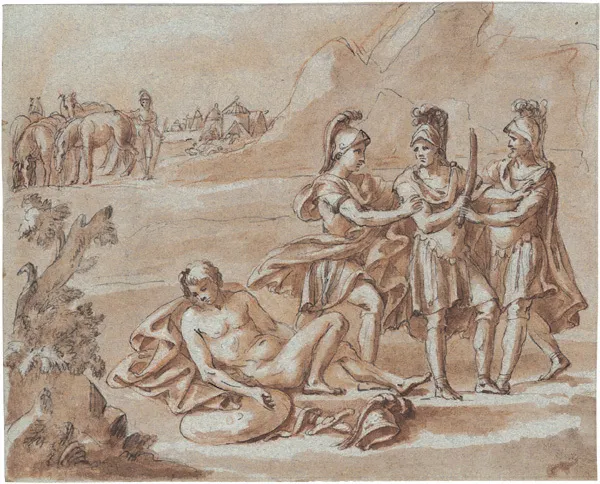
Peter Anton von Verschaffelt (Gent 1710 – 1793 Mannheim) – Dying warrior.
Ink drawing in black brown with red chalk with the remnants of bordering in pencil. On delicate grey blue laid paper with watermark „WAKNST“.¹ Size: 20,5 x 26 cm. On the left margin original mounting on yellow coloured laid paper base with watermark „HB“ (H. Blum).
Provenance: Private collection, Baden-Württemberg, acquired in the Stuttgart art market in 1974.
The scene at hand shows a naked warrior, lying on the ground with his head turned to the side and his right leg bent, next to him his shield, helmet and sword. In the right hand part of the drawing stands the commander in armour, flanked by two warriors, who are preventing him from attacking the prostrate warrior again. Sketchily implied in the background one can observe an encampment in the mountainous landscape. The theme itself probably belongs to a mythological field of topics, as the persons in the group of figures with the commander are wearing the typical Greek helmets with hackle.
¹ Cf. Jaffé 1935, No. 20b. Paper mill Wolfgang Adam Knöckel, Neustadt.
Verschaffelt – Nr 15
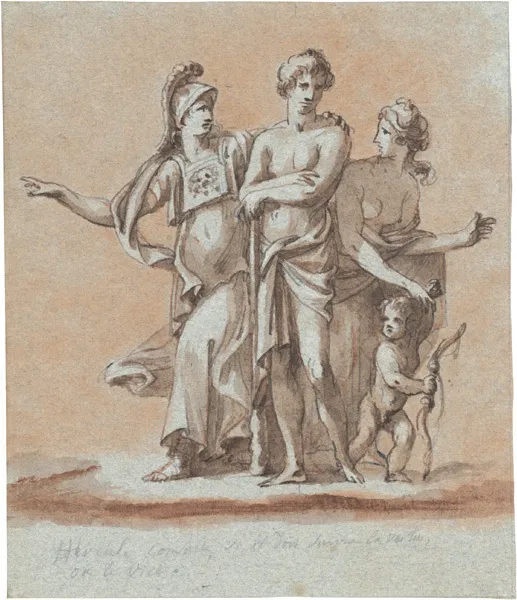
Peter Anton von Verschaffelt (Gent 1710 – 1793 Mannheim) – Heracles at the crossroads.
Ink drawing in brown with red chalk. Original marking in pencil „Hercule conseille, s’il doit suivre la vertue ou la vie“. On delicate grey blue laid paper with watermark „WAKNST“ (fragment).¹ Size: 20,8 x 17,5 cm. On left margin original mounting on yellow coloured laid paper base with watermark „IV“.
Provenance: Private collection, Baden-Württemberg, acquired in the Stuttgart art market in 1974.
This pictorially executed drawing shows a scene from Greek Mythology. The young Heracles stands between the goddess Athena and the goddess Aphrodite, who is accompanied by a small Cupid. They personify the virtue, or rather lust and show the hero the way to fame and honour or to pleasure and wealth. The whole composition of the drawing is well balanced and harmonious. The centrally placed, almost static figure of Heracles is flanked by the two female figures, each pursuing different ways, thus elucidating the dilemma of the hero.²
¹ Cf. Jaffé 1935, No. 20b. Paper mill Wolfgang Adam Knöckel, Neustadt.
² Cf. Städtisches Reiss-Museum Mannheim, P. A. von Verschaffelt, Mannheim 1976, No. 70 c.
Verschaffelt – Nr 16
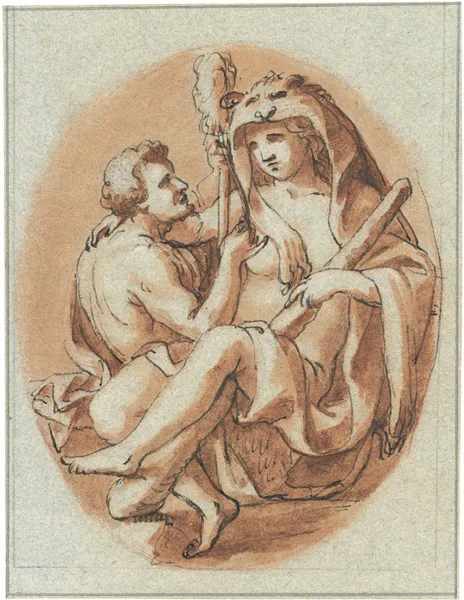
Peter Anton von Verschaffelt (Gent 1710 – 1793 Mannheim) – Heracles and Omphale.
Depiction in oval form. Ink drawing in black brown with red chalk, mainly with double bordering. Verso with remains of a figure sketch in red chalk. On grey blue laid paper with watermark „IFLNST“.¹ Size: 15,4 x 11,6 cm. On left margin original mounting on pale yellow coloured laid paper base as well as marking verso „F. No.179“.
Provenance: Private collection, Baden-Württemberg, acquired in the Stuttgart art market in 1974.
In his drawing works, Verschaffelt treated this subject many times.² As a punishment for stealing the Delphic Tripod, Heracles was sold as a slave. During his one years period of service, the hero became so effeminate, that he passed his attributes of club and lion skin to Omphale, and from this time on sat at the distaff in women’s clothes. Whilst two drawings in the Reiss-Museum show both the protagonists sitting or rather standing, a third drawing uses the ame conception as the work at hand. Using the oval format in a clever manner, the artist shows Heracles in side view, with the distaff in his hand, whilst Omphale sits opposite him with the lion’s skin and the club.
¹ Cf. Jaffé 1935, No. 14a. Paper mill Johann Friedrich Lorch, Neustadt.
² Cf. Städtisches Reiss-Museum Mannheim, P. A. von Verschaffelt, Mannheim 1976, No. 70ff.
Verschaffelt – Nr 17

Peter Anton von Verschaffelt (Gent 1710 – 1793 Mannheim) – The centaur Nessus, with Deianeira and Heracles.
Ink drawing in black brown with red chalk and pencil with bordering in black brown ink. On delicate grey blue laid paper with watermark „Crowned double C“.¹ Size: 23,9 x 33,1 cm. On left margin original mounting on beige coloured laid paper base with watermark „Crowned double C“ as well as marking verso in brown ink „A. No. 94“.
Provenance: Private collection, Baden-Württemberg, acquired in the Stuttgart art market in 1974.
As with the two previous catalogue numbers, Verschaffelt once again treats a subject from the sagas of Heracles. The drawing at hand shows the moment before the centaur Nessus carries the wife of the hero over the river on his back. In the middle of the river the centaur, bewitched by Deianeira’s beauty, tries to kiss her, where upon Heracles kills the centaur with an arrow shot. Verschaffelt places the main focus of the events in the left part of the depiction. The figures stand at a tree-lined riverbank. They are worked out in great detail and accentuated, both in the stroke lines and in the red chalk handling. Whereas the surrounding landscape is only scenically implied.
¹ Cf. Jaffé 1930, No. 33.
Verschaffelt – Nr 18
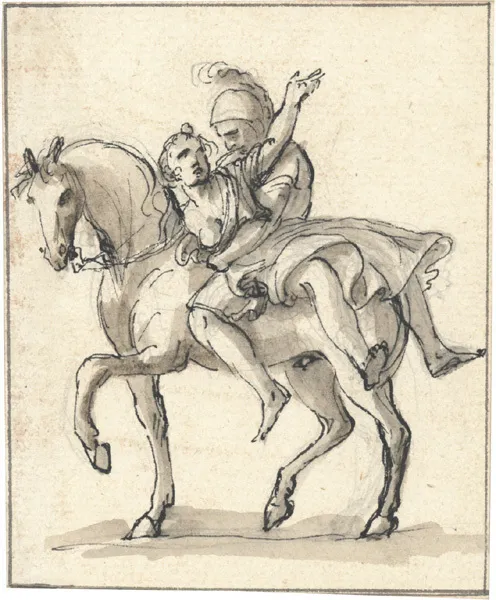
Peter Anton von Verschaffelt (Gent 1710 – 1793 Mannheim) – Rape of a Sabine Women.
Grey brown washed Indian ink drawing with pencil and bordering. Verso fragment of a pencil sketch (architectural study). On strong beige coloured laid paper. Size: 11,3 x 9,4 cm. On left margin original mounting on pale yellow coloured laid paper base and as well as marking verso in brown ink „F. No. 221“.
Provenance: Private collection, Baden-Württemberg, acquired in the Stuttgart art market in 1974.
The abduction of a young woman by a Roman rider belongs to the subject matter of the Rape of the Sabines. This is probably a detailed study of the figure rich scene recorded by the Reiss-Museum, Mannheim under the inventory number „LBW 1974/2/358“.¹
¹ Cf. Städtisches Reiss-Museum Mannheim, P. A. von Verschaffelt, Mannheim 1976, No. 77 a.
Verschaffelt – Nr 19
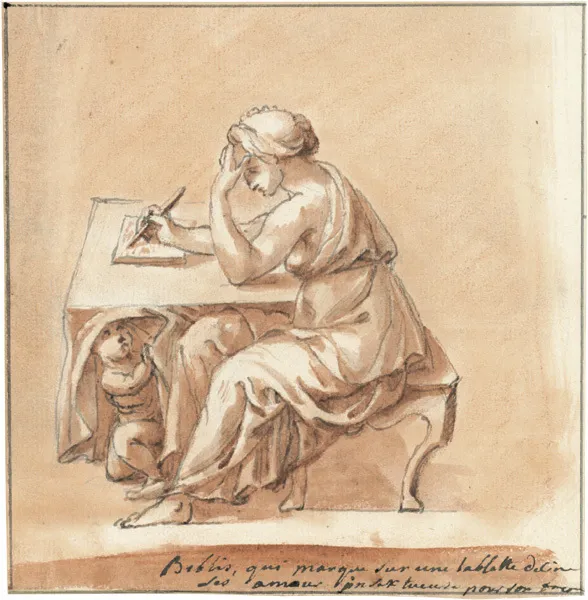
Peter Anton von Verschaffelt (Gent 1710 – 1793 Mannheim) – Byblis writes to Caunos. Indian ink drawing with red chalk and bordering.
Original marking in brown ink „Biblis, qui marque sur une tablette deline ses amours incestueuse pour son frère“. On beige coloured laid paper with watermark „WAKNST“.¹ Size: 15,8 x 15,6 cm. On the left margin original mounting on yellow coloured laid paper base with watermark „Crowned coat of arms with lily“ (trimmed) and as well as marking verso in brown ink „A. No. 94“.
Provenance: Private collection, Baden-Württemberg, acquired in the Stuttgart art market in 1974.
In the hall of ancient works in the Mannheimer Zeichnungsakademie, there was a non-identified group of figures with the title „Caunos and Byblis“.² This sculpture probably encouraged Verschaffelt to involve himself with the story of the unrequited love of Byblis to her twin brother Caunos, described in the 9th book of the Metamorphosis. She yearned for him and after battling with herself for a long time, decided to tell him about her feelings. The drawing at hand stands in close conjunction with a further drawing in the Reiss-Museum in Mannheim, which shows how Byblis wants to pass a letter for Caunos to a messenger, but the correspondence falls to the ground.³
¹ Cf. Jaffé 1935, No. 20b. Paper mill Wolfgang Adam Knöckel, Neustadt.
² Cf. Mannheimer Geschichtsblätter 1931, column 154f.
³ Cf. Städtisches Reiss-Museum, P. A. von Verschaffelt, Mannheim 1976, No. 72 i.
Verschaffelt – Nr 20
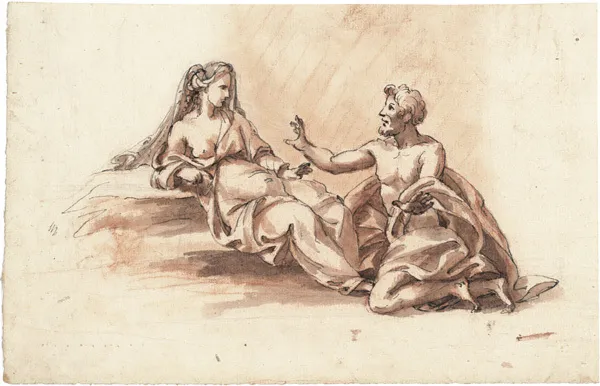
Peter Anton von Verschaffelt (Gent 1710 – 1793 Mannheim) – Nike and an ancient ruler.
Ink drawing in brown with red chalk and pencil. On beige coloured laid paper with watermark „H. Blum“. Size: 33,6 x 41 cm.
Provenance: Private collection, Baden-Württemberg, acquired in the Stuttgart art market in 1974.
The catalogue of the Reiss-Museum in Mannheim mentions under the inventory number „LBW 1974/2/267“ a drawing with the same theme.¹ The winged figure shown here is Nike, or possibly a large winged genius, who is showing the way to the figure of a ruler in ancient armour, seated at a reading desk. The backdrop is presented in form of a hall with prominent columns, which is executed in great detail.
¹ Cf. Städtisches Reiss-Museum Mannheim, P. A. von Verschaffelt, Mannheim 1976, No. 77 c.
Verschaffelt – Nr 23
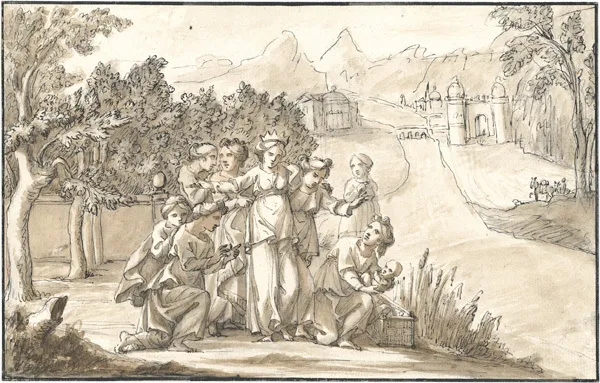
Peter Anton von Verschaffelt (Gent 1710 – 1793 Mannheim) – The discovery of little Moses.
Brown washed Indian ink drawing with red chalk.
On strong chamois coloured laid paper with watermark „Crowned coat of arms with lily“. Size: 19,7 x 31 cm. On the left margin occasionally originally mounted on green coloured laid paper base with watermark „Letter B with clover leaf“ as well as marking verso in brown ink „A. No. 7“.
Provenance: Private collection, Baden-Württemberg, acquired in the Stuttgart art market in 1974.
According to the Old Testament, Moses was abandoned as a newborn baby, but was saved by the daughter of the Pharaoh and brought up by her. The drawing at hand demonstrates Verschaffelt’s abilities to perfection. The experience of the sculptor can be seen in the quality of plasticity achieved in the figures. In this work the French influences are mixed with Flemish-Italian Baroque elements.¹
¹ Städtisches Reiss-Museum Mannheim, P. A. von Verschaffelt, Mannheim, 1976, passim.
